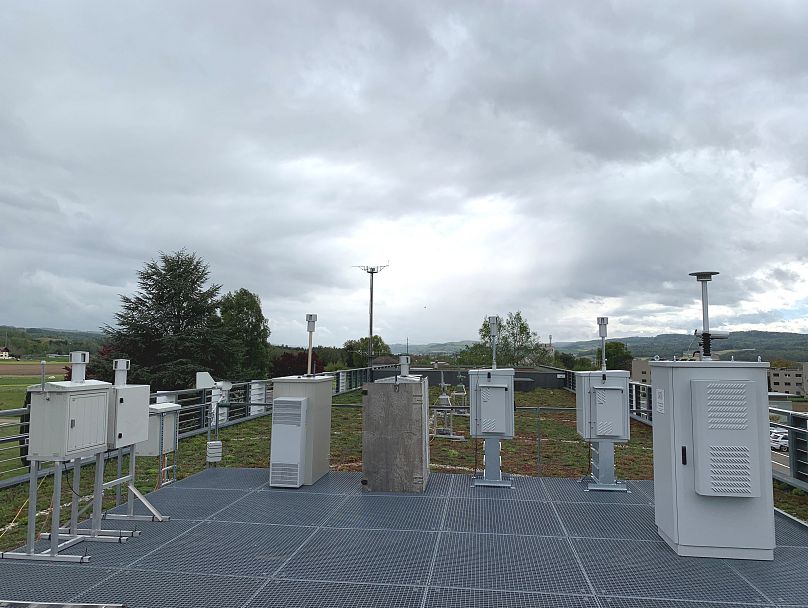The Copernicus Atmosphere Monitoring service (CAMS) recently formed a new partnership with the European Aeroallergen Network (EAN,) and will explore ground breaking technology to deliver automatic pollen observations in near real-time across Europe.
Every year during spring and early summer comes a chorus of sneezing, wheezing and sniffling, because this is peak hay fever season - an unfortunate truth for one in four Europeans. Living in the city provides no respite either, as air pollution intensifies the suffering. On top of that, rising temperatures caused by climate change mean that plants and trees bloom earlier and for longer, prolonging the suffering for a hundred million Europeans with pollen allergies.
The pollen problem is getting worse, and today’s forecast methods simply aren’t accurate enough to truly help people avoid the misery that the warmer weather brings. Predictions will give us an idea, based on which plants are due to bloom, the weather conditions and the air pollution, but this is simply an estimate - actual pollen measurements only become available about a week after observations are made.
Fortunately, this is set to change. The Copernicus Atmosphere Monitoring Service is working with the European Pollen Database and the AutoPollen programme at MeteoSwiss to coordinate the development of new technology - the goal is provide near real-time data about the pollen that’s in the air right now. This, combined with CAMS’ extensive experience with air quality forecasting, will be a significant boost to the health and happiness of Europeans who are currently suffering through the erratic pollen season with nothing but educated guesses.
Daily CAMS forecasts are evaluated by comparing them with observational data from more than 400 active ground stations run by the EAN, whose database is hosted by the Aerobiology and Pollen Information Research Unit at the Medical University of Vienna. This is the largest non-commercial pollen data collection in the world, and includes information from about 40 countries, mostly in Europe. Pollen research is often local because the conditions are strongly dependent on the region, but the European Pollen Database aims to ensure the data are compatible in order to support scientific projects and clinical trials across the continent.
Today’s system: An educated guess
“Currently, the main technique for measuring pollen is the volumetric Hirst trap, which measures daily pollen concentration by sucking in the airflow. The pollen is then manually counted in a lab,” says Maximilian Bastl from the Austrian Pollen Information Service. The most common pollen allergies in Europe are birch, olive, and grass, but Bastl, who’s an administrator at the European Pollen Database, says that pollen monitors will test for at least the 26 most common types, or sometimes as many as 70 - the goal is to keep adding new plants and fungi to cover even the more rare allergies. The Hirst trap is however only emptied weekly: “Analysis takes a couple of days [on top of that], but it's the standard for all observations that we have,” says Bastl.
So before the actual pollen count reaches the public, a week has passed. Having the real pollen count is still valuable as it improves future forecasts and it helps record patterns over time, but it’s still all based on averages - we can’t tell if a species suddenly starts releasing pollen early this year, for example. What’s worse, many of the pollen forecasts available to the public via free apps don’t even have this imperfect after-the-fact quality control, meaning people have no way of knowing if what they’re seeing is at all accurate.
In the future: From a week to an hour
What’s the point then, you may ask - none of this helps a pollen sufferer who needs to know if there will be a lot of ragweed down by the river this afternoon. Bernard Clot, Manager of the AutoPollen Programme at MeteoSwiss, says this is a question he gets often, and this is also what they’re working to address: “The goal isn't to automate the pollen count, but to have the data in near real time to inform patients and doctors in a timely manner.” A number of new technologies are currently being explored to achieve this, ranging from lasers to particle capture, to taking photos of airflow. “They all have in common that the result will be pretty much immediate,” says Clot. “Pollen counts will go from one week to one hour.”
But just because data hasn’t been immediate until now, it doesn’t mean that researchers haven’t been exploring ways to help hayfever sufferers. “Existing pollen models are imperfect, but they are suitable for clinical trials for measuring direct health impact on people,” says Mikhail Sofiev, deputy group leader at the Atmospheric Composition Modelling at the Finnish Meteorological Institute. In a pilot project, Sofiev and his team are working on predicting the individual symptoms of people using existing data and their personal hayfever diaries. “For some patients, air quality is an important factor too, so that’s been incorporated. We are still developing the model and will know more soon,” says Sofiev.
The gold standard: pollen + weather + air pollution
Copernicus has over 40 years’ of climate data, which has enabled the organisation to track how global warming has affected over 100 species. Flowering patterns are changing with seasons - often starting earlier and lasting longer. However, it’s not the same in every country: the change in grass pollen patterns may be different in France and Greece. Local factors also mean that a high amount of pollen in one year can be less impactful than a moderate pollen level the next, depending on air pollution and the weather.
Numerous teams across Europe are currently working on solving this problem. Bavaria’s ePIN network, which is already automated, has been up and running since last year, and in Serbia, real-time data are already feeding the RealForAll app that’s available to the public. But in many countries across the rest of Europe, hay fever sufferers are keenly awaiting the arrival of reliable, real-time measurements. For some, relying on forecasts isn’t just irritating: “We could even be harming patients with the wrong information. We could be telling them it’s safe to go out, only for them to be coming back to the hospital with asthma or worse,” says Uwe Berger, head of the research group for pollen information at the Austrian Pollen Information Service.
In order to give people the pollen information they need to stay healthy and happy, forecasts need to become accurate in real-time and need to look at the big picture. “We need to thoroughly consider the impact pollen has on people’s health,” concludes Vincent-Henri Peuch, Head of the Copernicus Atmosphere Monitoring Service. “That means looking at it alongside meteorological data, and air quality. It’s become clear in the medical sector that it’s all interlinked.”








